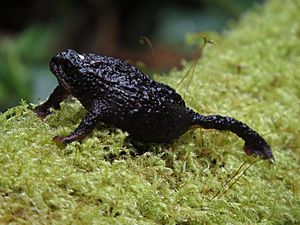Herveo plump toad facts for kids
Quick facts for kids Herveo plump toad |
|
|---|---|
 |
|
| Conservation status | |
| Scientific classification |
The Herveo plump toad (Osornophryne percrassa) is a special kind of toad. It belongs to the Bufonidae family, which includes many different types of toads. This toad is found only in a specific part of Colombia, South America. It lives in the high mountains of the Central Mountain Range. You can find it in the areas known as Antioquia, Caldas, Quindío, and Tolima Department.
What Does the Herveo Plump Toad Look Like?
Herveo plump toads are quite small. Male toads are about 23 to 28 millimeters long. That's less than an inch! Female toads are a bit bigger, measuring about 27 to 38 millimeters. This measurement is taken from their snout (nose) to their vent (the opening at the end of their body).
These toads have a unique look. Their snout, when seen from the side, looks like it's cut off flat. At the very end of their snout, they have a tiny bump or "papilla" that doesn't stick out much. Another special feature is the light-colored spots on their belly. These spots help tell them apart from other toads in the Osornophryne group.
Where Does the Herveo Plump Toad Live and How Is It Protected?
The Herveo plump toad lives in cool, moist places high up in the mountains. Its natural habitats include Andean forests and special high-altitude grasslands called páramos. These areas are found at elevations between 2,700 and 3,700 meters above sea level.
This toad usually lives on the ground. You can find it hiding among fallen leaves and rocks. Sometimes, it also lives inside bromeliads. Bromeliads are plants that often grow on trees or rocks and can hold water.
The Herveo plump toad is not very common. It faces several challenges that threaten its survival. One big problem is habitat loss. This means that the places where they live are being destroyed or broken up. This often happens because of agriculture, where land is cleared for farming. Another threat is pollution, which can harm their environment. Even climate change might be a danger to these toads in the future.
Good news is that some of these toads live in protected areas. These special places help keep their homes safe from harm.
See also
 In Spanish: Osornophryne percrassa para niños
In Spanish: Osornophryne percrassa para niños


